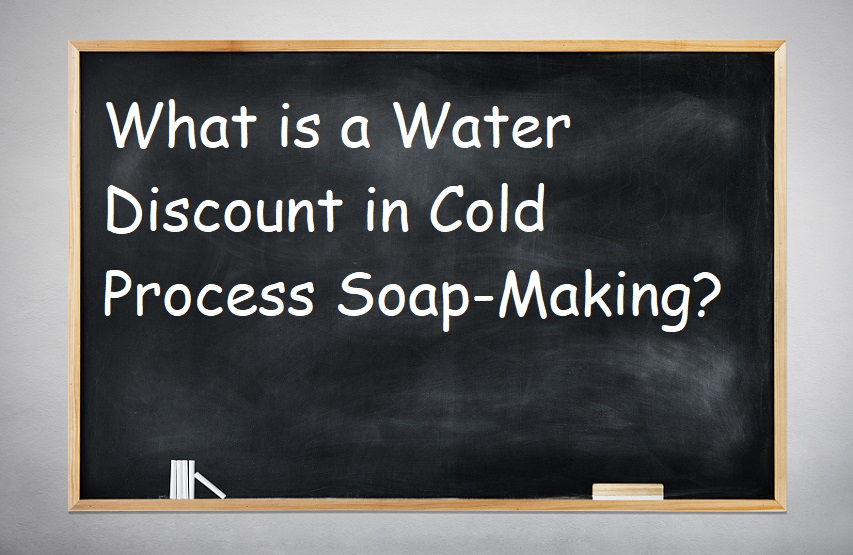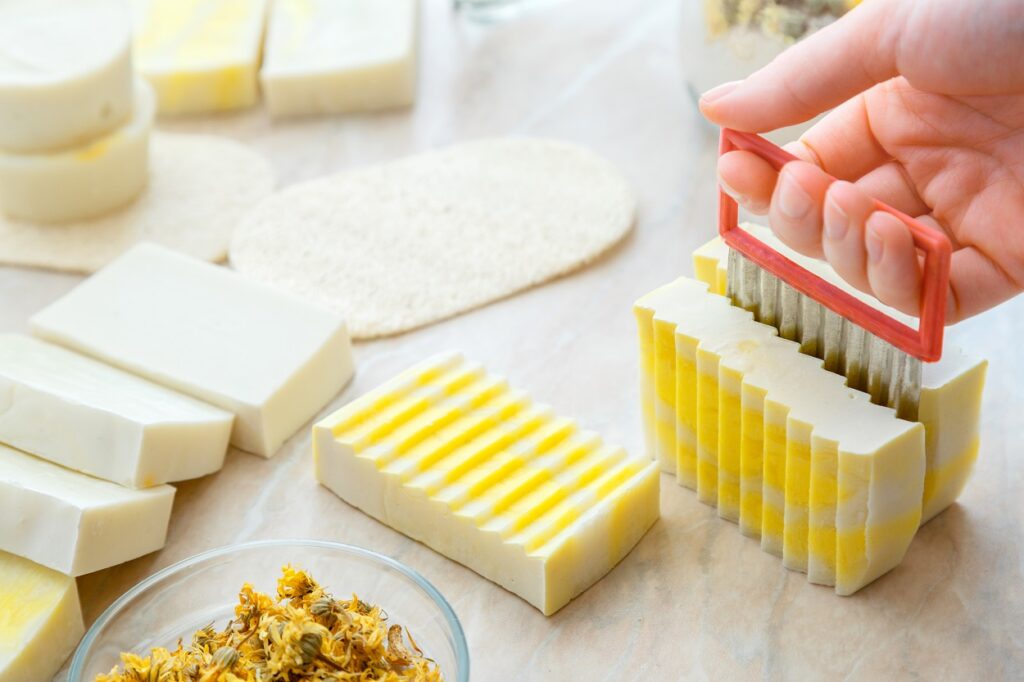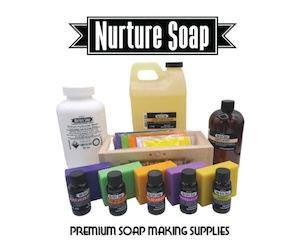Water Discount In Soap Making:
Another fancy (yet important) term in the world of soap making is a water discount. To understand water discount in soap making, it’s helpful to understand the basics of cold process soap making. The same can be said about other important terms, such as; lye solution, base oil properties, saponification, saponification values, and so forth.

It may also be beneficial to have working knowledge and understanding of how to work with soap calculators and recipes. The goal with cold process soap making is to be able to customize every aspect of your soap.
Soap makers know that lye + water, added to your oils/fats, reacts chemically to form a new substance, which is that of soap. All those molecules react to one another, which results in your lye being “used up”, leaving some oils remaining (if you superfat). Then, the final product is beautifully crafted soap.
Easy, right!?
Water Discount In Soap Making Made Simple!
After choosing your oils, scents, and deciding what technique you might try with your next soap batch, you may choose to do a water discount.
A water discount means that the “normal” amount of water for a particular recipe has been reduced (usually by a percentage amount). As your soap cures, water is consistently evaporating and your soap begins to harden. If you choose to “water discount”, your soap batch will have less water in it’s recipe, therefore will need less time to evaporate, leading to a faster cure.

* Understand that there is not an “exact” amount of water to use. Adjusted water levels in your recipe, can effect things like, trace, gel phase, designs, aesthetics in the end product, etc. The amount of water will effect your lye concentration. *
Why do this?
Having a water discount will do a few things for your recipe:
- Firms up in the soap mold faster (higher concentration of lye = faster emulsification process).
- Shorter curing time, once unmolded.
- Helps the soap to reach trace faster.
- Reduces the chance of soda ash.
- Reduces the chances of glycerin rivers.
Another reason soapers choose to do a water discount is do to other things they may add to their recipe. For example, a recipe that calls for puree’s, like pumpkin puree or apple puree (which have their own water amounts). Soapers may decrease the water in their lye solution to compensate for the puree. Many soapers begin with a 10% water discount.
Last but not least, a water discount effects “gel phase”. If you don’t know what gel phase is, this is another crucial element of cold process soap making, certainly one you’ll need to understand. Oftentimes, when you decrease the water amount, it’s harder for gel phase to occur and gel phase lasts for a shorter interval. If this is the case their are ways to force gel, so don’t be to concerned.
Related Article: Gel Phase in Cold Process Soap Making: The Temperature Is Rising!
* If you plan on doing intricate designs, be careful how much you water discount, as it will trace faster, giving you less time to work with your design.
“Full Water” vs. Other “Common” Lye Solution Strengths!
Full Water:
Many times you’ll see recipes call for a “full water” amount. Usually this is referred to as a 25% lye solution. This simply means 25% lye and 75% water.
Remember this when thinking about other solution strengths. The higher the amount of water in your “solution”, the slower trace will occur, theoretically. This may be beneficial for some recipes. However, the more time needed to unmold or cure, as more water will need to evaporate.
The more water also means the MORE likely you will get a full gel phase. This is something that seemed reverse to us when we first began soaping. More water = better chance at a fully gelled soap. In some cases this may be ideal, as “gelled” soap usually comes out with more vibrant colors, and a more shiny appearance. It’s all preference.
33% Lye Solution:
For us, this was our go-to lye solution concentration, and is still one we use heavily in our soap-making process.
It helps for a few different reasons. The water amount is less then the beforementioned concentration we discussed. However, in general, still gives us time for designs. Furthermore, it helps when unmolding and faster cure times.
Why?
Simple. Less water to evaporate. Remember, this also reduces time for the soap to gel. Consequently, this may be a case where you have to help it along. For example, using a heating pad, or the “oven method” of forcing soap through gel.
The Other End of the Spectrum (50% Lye Solution):
This would be the least amount of water that can be used to fully dissolve the lye used.
This solution yields a 50% water and 50% lye solution. This is obviously an extremely concentrated lye solution. In this situation, conditions for the lye solution need to be perfect for lye not to precipitate out of the solution.
You also run the risk of lye not fully dissolving if you don’t have an “ideal environment”. This can create issues when the saponification process is occurring, leaving pockets of lye. We’ve never used this concentration in one of our soaps. Most likely the only time we would use it, is with additional additives that would add to the “water” amount. For example, milks or puree’s.
Cons of Water Discounting:
- Less time to work, accelerates trace so intricate designs may be difficult to pull off.
- May stay a max temperature for a shorter duration, and may not go through “full” gel phase.
- If you water discount to much, your run the risk of not having enough water to fully dissolve the lye.
Final Thoughts!
Please share your thoughts and some of your personal favorite recipes where you may have used a water discount or other fun recipes in general.
Thanks so much for coming by! We hope to have you again soon.



